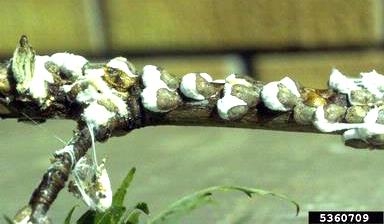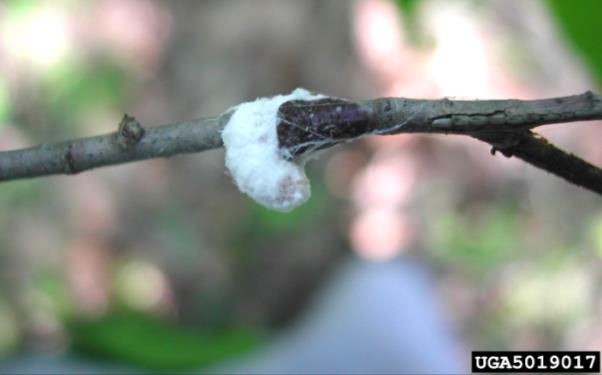Cottony Maple Scale
ID
2808-1011 (ENTO-411NP)
Description
Heavily infested plants have large numbers of scale insects on the branches and twigs (Fig. 1). Scale insects feed on plant sap with their long, thread-like mouthparts (stylets), which are six to eight times longer than the insect itself. Feeding by scales slowly reduces plant vigor. Large numbers of scales will reduce the amount of nutrients reaching the leaves, causing the foliage to turn yellow and fall prematurely. Heavily infested plants grow poorly and may suffer dieback of twigs and branches. Occasionally, an infested host will be so weakened that it will die.

Plants Attacked
Primarily found on silver maple, boxelder, and other maples. Also found on dogwood, oak, white ash, apple, sycamore, elm, poplar, and locust.
Identification
Immature cottony maple scales are small, flattened ovals and pale green in color during winter. They begin to mature with warmer spring weather. By late spring the scales are brown and elongated with their characteristic white, cottony egg mass attached under the brown bodies (Figs. 1 and 2).
Hemiptera: Coccidae, Pulvinaria innumerabilis (Rathvon)

Life History
Eggs are laid in April and June and hatching occurs throughout the early summer. Crawlers settle on leaves and stems. Male scales complete development by fall and mate with the immature females. Before the leaves drop from trees, female scales migrate to the stems and twigs where they overwinter. In spring the female reaches maturity and lays a distinctive cottony egg mass. There is one generation per year.
Control
Dormant oil can be applied to the overwintering stages in late spring before new plant growth starts. During the growing season when dormant oil should not be used, insecticide treatments must be timed correctly against the immature scales, called the crawlers, before they settle and begin producing their waxy coverings. Crawlers are usually present between June 5 and June 25 in Virginia. Treat with insecticides between June 10 and 20. Insecticide treatment of adult scales is ineffective because the adults are protected from insecticides by their waxy coverings. See the Virginia Pest Management Guides for specific insecticides for control. Care should be taken when applying insecticides, because they may deplete the number of natural enemies that normally control the pest insects.
Remarks
Natural enemies heavily feed upon cottony maple scales and in some cases chemical controls are not needed. This scale is sometimes confused with the related maple leaf scale (Pulvinaria acericola), which settles on leaves and produces its egg mass there. In contrast, the cottony maple scale primarily settles and produces egg mass on the branches and stems.
Revised
Olivia C. McCraw, June 26, 2014; Theresa A. Dellinger, January 23, 2021.
Virginia Cooperative Extension materials are available for public use, reprint, or citation without further permission, provided the use includes credit to the author and to Virginia Cooperative Extension, Virginia Tech, and Virginia State University.
Virginia Cooperative Extension is a partnership of Virginia Tech, Virginia State University, the U.S. Department of Agriculture (USDA), and local governments, and is an equal opportunity employer. For the full non-discrimination statement, please visit ext.vt.edu/accessibility.
Publication Date
February 2, 2021



